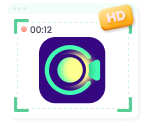How to Record Browser Audio [Full Guide]
This article is a detailed guide on how to record browser audio. It reviews various methods, such as browser extensions, QuickTime with Soundflower, and online tools. Each method is explained in terms of its benefits and limitations. The guide is designed to help anyone needing to capture audio from the web.
Try Screenify for free to record screen on Windows or Mac. Whether full-screen or partial-screen recording, recording with sound or with camera, Screenify can do it with ease.
Have you ever needed to record browser audio? This capability is essential, whether for online courses, saving favorite songs, or capturing podcast episodes. However, users often face hurdles such as limited features and varying audio quality. This article outlines practical solutions for efficiently recording browser audio, ensuring clear and usable results. We’ll guide you through various methods that fulfill different needs, from simple extensions to comprehensive tools like Screenify. Get ready to level up your audio recording experience with our detailed guide.
Part 1. How To Record Audio From a Website Using an Extension on Chrome/Firefox
Ever visited a website and wanted to save the audio? An extension on Chrome or Firefox is a simple way to do this. These browser extensions let you record audio directly from a webpage with just a few clicks. It’s an easy and efficient method for capturing podcasts, music, or audio content online.
Advantages
- Easy to Use: No technical skills are needed.
- Quick Access: Directly record without extra software.
- Free Options: Many extensions are free.
Disadvantages
- Limited Features: Basic compared to full software.
- Quality Varies: Audio quality may not be perfect.
- Browser Dependency: Only works on supported browsers.
Ideal for
- This method is ideal for those who need quick, no-fuss audio recordings. It’s perfect for casual users or anyone looking to save audio without installing heavy software.
Steps to Record Audio From a Website with an Extension on Chrome/Firefox
Here are the steps to record browser audio using an extension on Chrome/firefox.
Step 1. Install the Extension
Go to the web store on your browser. Then search for Screencastify on Chrome/Chrome Audio Capture or Live Recorder on Firefox. Next, click Add to Chrome/Firefox to install the extension on your web browser.
Step 2. Open the Extension
After installing, locate and click the extension icon in the top-right corner of Firefox or Chrome.
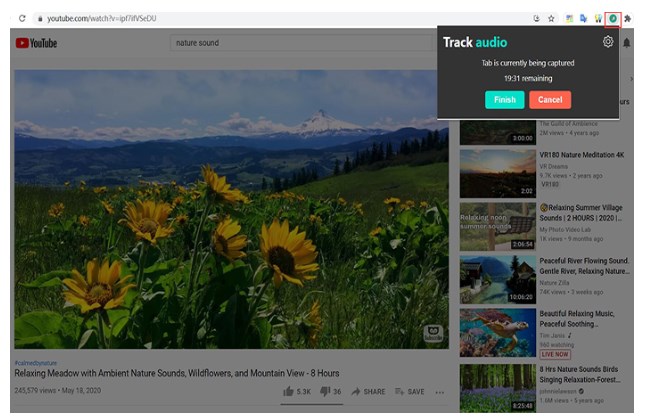
open the extension
Step 3. Record Browser Audio
Play the audio you would like to record on the web pages. Then, click Start Capture to record audio from Chrome or Firefox.
Step 4. Save the Recording
When finishing the recording, click Save Capture to save the recorded audio on your computer.
That’s all about this method! Let’s discuss the next method to record browser audio on our list.
Part 2. How To Record Audio From a Website Using Screenify (HD & Free)
Screenify is an all-in-one screen recording tool for Windows and macOS users, completely free to use. It supports ultra-clear recording up to 4K 60FPS, and provides multiple recording modes and unlimited recording time.
Compared with other audio recording methods, Screenify provides more comprehensive functions.
- 100% free: users can enjoy all the features without paying any fees.
- Support 4K 60FPS recording: can record high-quality videos, suitable for professional content creators.
- Multiple recording modes: including full-screen recording, area selection recording and locked window recording, flexible to meet different usage scenarios.
- Unlimited recording time: no limit on recording time, convenient for users to capture content completely.
- Freely set watermark: support adding text watermarks to protect video copyright or for brand promotion.
- Support multiple file formats: record and output in multiple formats, convenient for compatibility and dissemination of different platforms.
- Smooth Browser Audio Recording: Users can seamlessly record directly from the browser.
- Comprehensive Functions: Also supports options such as adjusting audio quality, managing background noise, and integrating with cloud storage.
You have seen Screenify is a comprehensive tool to record browser audio.
Steps To Record Audio From a Website Using Screenify
Step 1.Download and Install Screenify on Computer.
Step 2.Launch Screenify on your computer, and select Record screen mode.
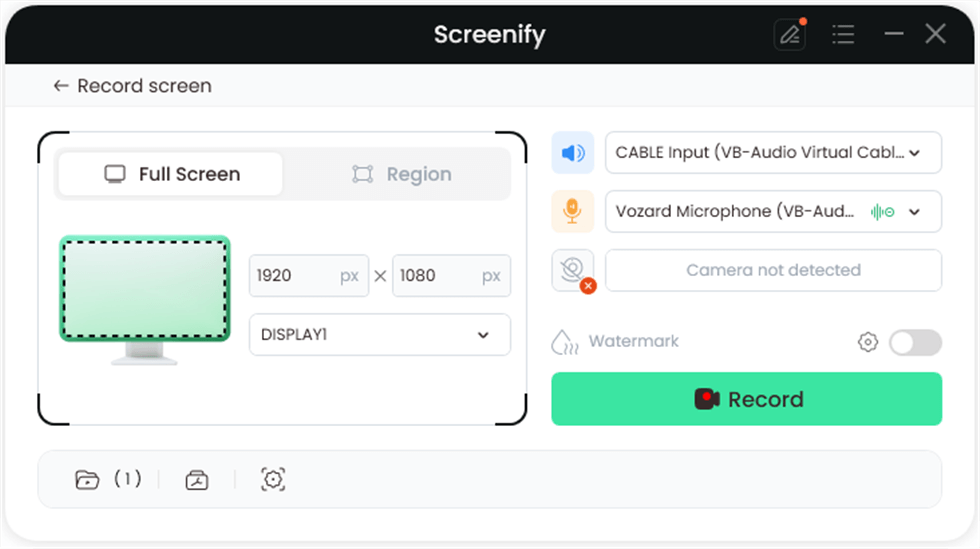
Select Record Screen Mode
Step 3.Configure Recording Settings aims to configure settings like system audio before recording.

Record Setting
In this setting menu, you can:
1 Choose the System audio.
2 Choose the Microphone you want to record.
3 Choose the Camera you want to use.
4 Choose whether to add a watermark.
Step 4.Select Recording Screen.
The screen mode offers two recording options: you can either record the entire screen or select a specific region to record.
Option 1. Full Screen Record
Please select Full Screen mode and choose the display you need to record. Hit Record button to initiate recording.
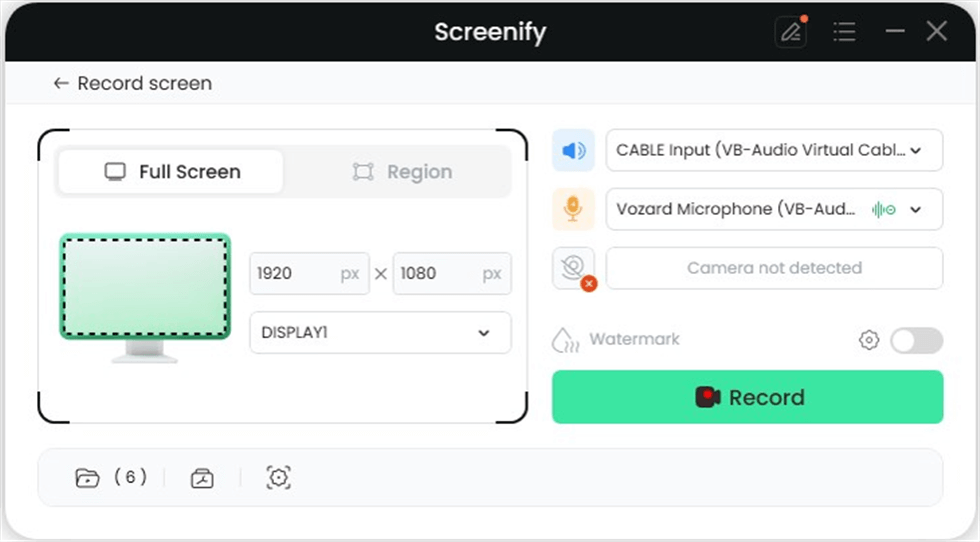
Full Screen
Option 2. Region Record
To record region, you need to manually select the recording area. After selection, you can still adjust the selected area. It supports customize selection, full screen, and proportional selection based on common social media dimensions.
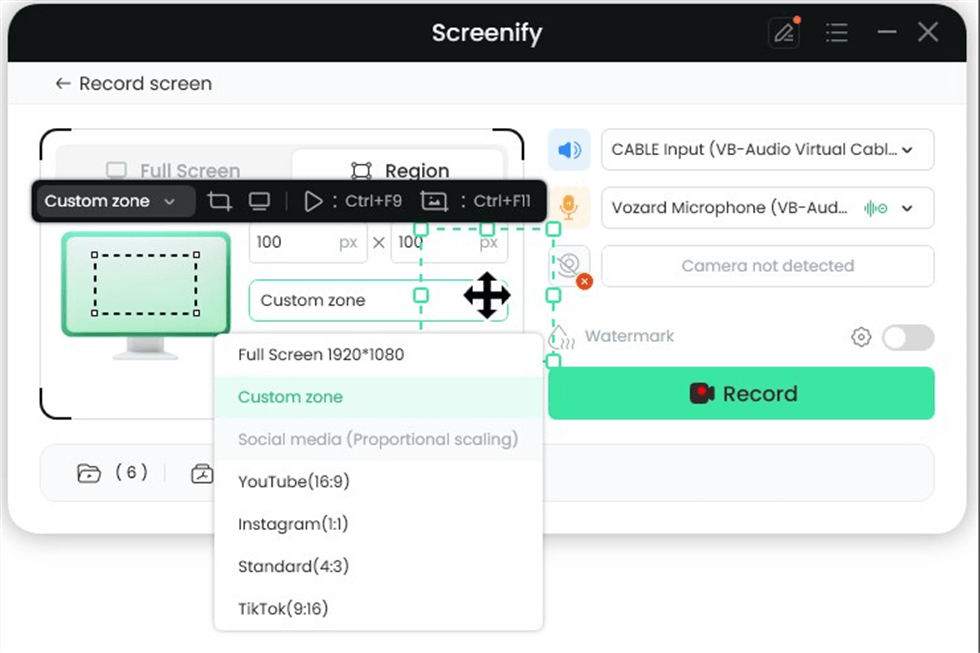
Record Region
Step 5.Wait for the Recording Countdown.
There is a 3-second countdown to help you prepare the recording after you are ready to start recording.

Start recording countdown
If you would like to see a recording countdown before your recording starts, you can enable the countdown option. Or you can tap it off. View this post to know how to set the countdown option.
Step 6.Start Recording.
The recording will begin after a 3-second countdown. You can make annotations on the recording interface during the recording.
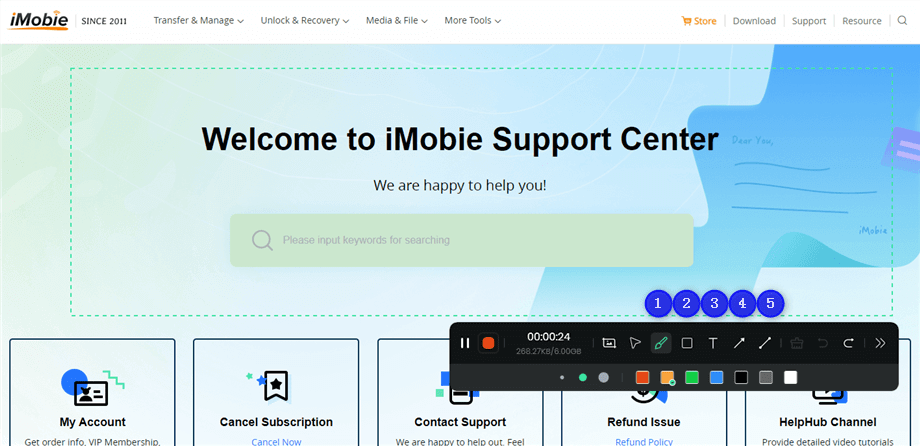
Annotate the Screen during Recording
With the toolbar, you can add the annotation in the screen:
1 Brush: Draw freehand on the screen recording interface to highlight or illustrate specific areas during the recording.
2 Rectangle: Draw rectangular shapes on the screen recording interface.
3 Text: Add written notes or labels directly onto the screen recording interface.
4 Arrow: Draw arrows on the screen recording interface to point out and emphasize specific areas.
5 Line: Draw straight lines on the screen recording interface to underline or connect specific points.
The toolbar can be expanded or collapsed. This feature allows you to access various tools and options when needed, and hide them to keep the workspace uncluttered when they are not in use.
Step 7.Record Screen Process Completed.
When the recording is completed, you can click the red Stop button to end the recording. Your recorded files will be displayed. From here, you can preview and manage the recorded content as needed.
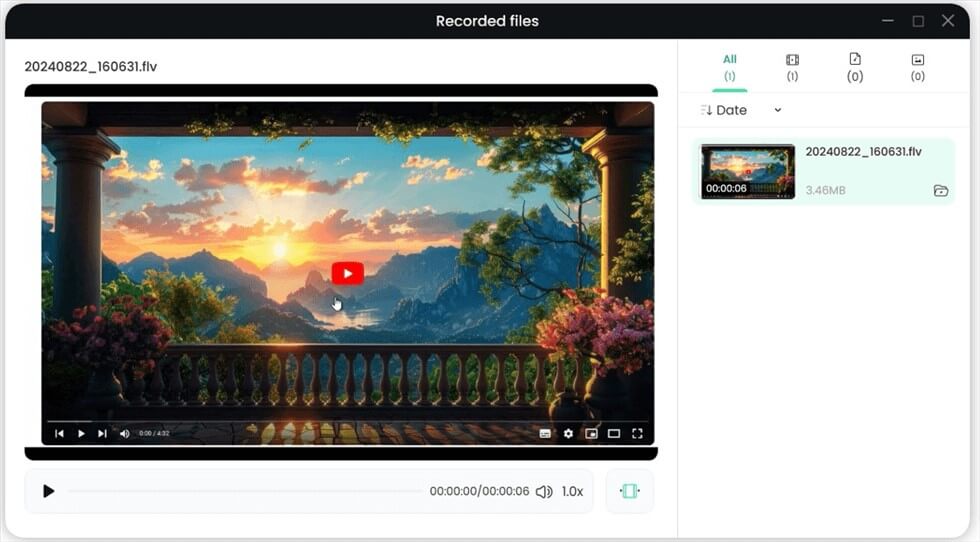
Record Screen Process Completed
Part 3. How To Record Browser Audio using Quicktime Player
Generally, Mac users can use QuickTime Player to record the screen and microphone sound. However, macOS blocks tools from capturing system audio directly. To record browser audio, you might need the Soundflower plugin. It’s a free tool that allows you to capture audio from your Mac.
Advantages
- Free and easy to use.
- No additional software for recording is needed, just QuickTime Player.
Disadvantages
- Installation of Soundflower can be tricky for beginners.
- It requires several steps to set up.
- Limited to recording audio from a single source at a time.
Ideal for
- Users who prefer built-in macOS tools.
- Those who need to record high-quality audio from their browser.
Steps to Record Browser Audio using QuickTime Player
Here’s how to record browser audio with QuickTime Player.
Step 1. First, download Soundflower from Git Hub and install it on your Mac.
Step 2. Go to System Preferences, then Sound, and Output. Next, select Soundflower (2ch), and check the “Show volume in menu bar” box.
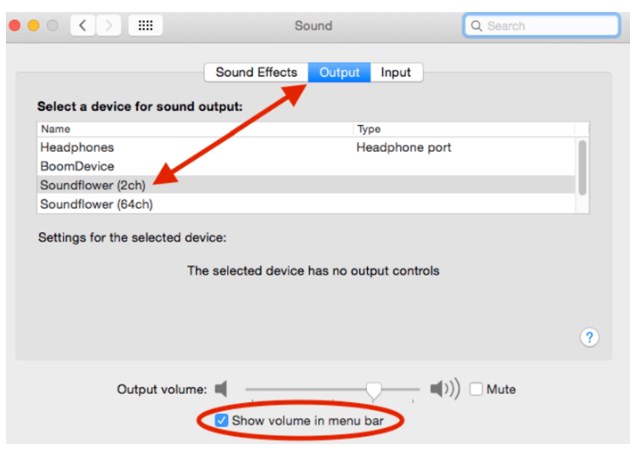
choose soundflower (2ch) and check the show volume
Step 3. Go to the menu bar, choose Option + Click on the speaker icon, and select Soundflower (2ch) in the drop-down list under Output device.
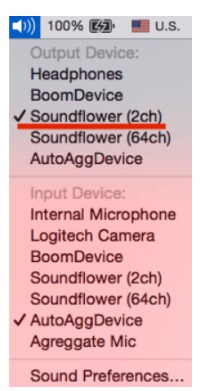
select soundflower (2ch)
Step 4. Launch QuickTime Player and choose New Audio Recording. Select Soundflower (2ch) as your microphone.

choose soundflower (2ch) as your microphone
Step 5. Back to the menu bar, tap the Soundflower icon and select “Built-in Output” under Soundflower (2ch).
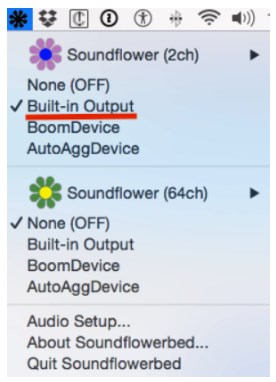
choose the built-in output under soundflower (2ch)
Step 6. Play the streaming audio on your browser. Finally, click the Start Recording button to record audio from websites.
We have covered everything about this method of recording browser audio. If it doesn’t work for you, don’t worry! Next, we’ll look at another efficient method.
Part 4: How to Use Online Tools to Record Audio in The Browser
Online audio recorders are a good option if you prefer not to download software or don’t trust extensions. They can easily record browser audio. Apowersoft Free Online Audio Recorder is one example.
It records audio from a single tab and saves it as an MP3 by default. However, it cannot record audio from multiple tabs at once.
Advantages
- No software download or installation is required.
- Easy to use with just a few clicks.
- Saves recordings directly as MP3 files.
Disadvantages
- Limited to recording audio from a single tab.
- Requires a stable internet connection.
- Some online tools may have ads or limitations in free versions.
Ideal for
- Users who want a quick and simple recording solution.
- Those with limited storage space don’t want to install additional software.
- Users who occasionally need to record browser audio.
Steps to Use Apowersoft to Record Browser Audio
Here’s a simple guide to using Apowersoft.
Step 1. Head to the online audio recorder website and click Start Recording.
Step 2. In the next section, you can record either system sound, microphone sound, or both. Then, click Start Recording again.
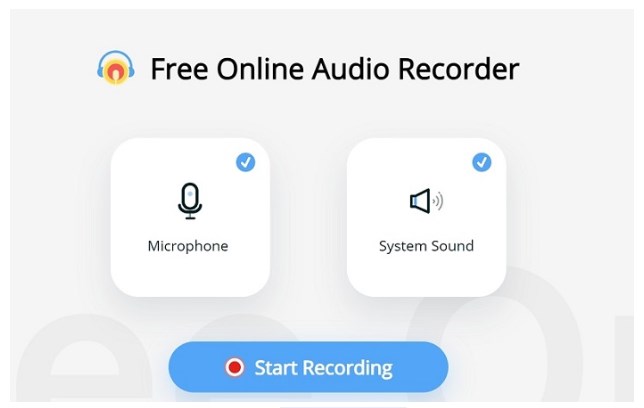
click start recording
Step 3. Select the browser tab where you wish to record the audio and tap Share to confirm. Note that you need to enable Share System Audio.
Step 4. You can preview your recorded file and save it as MP4 on your computer when you finish recording.
Now that you know how to record browser audio using online tools. Let’s discuss the best alternative if you don’t want to use any of the above methods.
Next, let’s compare the above-mentioned methods to choose the one that best suits your needs for recording browser audio.
Part 5. Comparison of All the Tools to Record Browser Audio
Have a look at the comparison table.
| Method |
Ease of Use |
Cost |
Features |
Reliability |
Ideal For |
| Extension on Chrome/Firefox |
Easy; no technical skills required |
Free; many extensions available |
Basic; limited to browser capabilities |
Depends on browser stability |
Casual users, quick recordings |
| QuickTime Player + Soundflower |
Moderate; setup can be tricky |
Free; requires free Soundflower installation |
Moderate; dependent on macOS tools |
High; uses native macOS tools |
Mac users, high-quality audio needs |
| Apowersoft Free Online Audio Recorder |
Very easy; few clicks to record |
Free; optional premium versions |
Basic; records to MP3, single tab only |
Moderate; requires stable internet connection |
Users without software installation needs, occasional recordings |
| Screenify |
Easy, user-friendly interface |
Completely free |
Comprehensive; includes advanced settings and cloud integration |
High; seamless browser integration |
Users seeking a robust, feature-rich tool |
This table will help you choose which method to record browser audio. Let’s now turn our attention to some frequently raised queries.
Part 6. FAQs of Recording Audio from the Website
1. How do I record audio from Chrome?
First, install an audio recording extension like Chrome Audio Capture to record audio from Chrome. After installation, click the extension icon. Next, choose ‘Start Capture,’ play the audio you want to record, and then click ‘Save Capture’ to download the file to your computer. This method is quick and straightforward.
2. How do I record my browser screen with audio?
To record your browser screen with audio, use Screenify. Install it from the Chrome web store. Next, click its icon to open, choose the screen and audio sources you want, and start recording. When done, click to stop and save the video with audio to your device. This tool makes the process easy and efficient.
3. How to extract audio from a web page?
To extract audio from a web page, use an audio recording extension like Chrome Audio Capture. Install the extension, navigate the page, click the extension icon, and start recording. Once finished, stop the recording and download the audio file to your device. This method is simple and effective.
Conclusion
In this guide, we explored multiple ways to record browser audio effectively. Whether using extensions, QuickTime with Soundflower, online tools, or Screenify, each method provides unique benefits depending on your needs.
For seamless integration and comprehensive features, Screenify stands out as a top choice. It’s entirely free, easy to use, and offers robust functionality for recording browser audio.
If you’re looking for a reliable solution that enhances audio quality and simplifies the recording process, Screenify is highly recommended. It’s ideal for anyone needing to capture audio from the web efficiently.

Joy Taylor


Senior writer of the iMobie team as well as an Apple fan, love to help more users solve various types of iOS & Android-related issues.
Screenify
AnyEnhancer
FocuSee
Vozard
AnyMiro
AnyMirror

